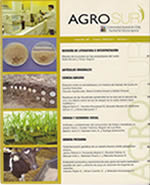Bermudagrass (Cynodon dactylon (L.) Pers.) yield and quality under different levels of salinity, nitrogen and trace minerals: A container trial evaluation
Main Article Content
Abstract
Salinity and shallow saline groundwater threaten agricultural sustainability in many irrigated regions of the world. We studied Bermudagrass (Cynodon dactylon (L.) Pers.) yield and quality under different soil salinity, nitrogen, boron, selenium and molybdenum contents in a container trial at the University of California, Davis campus in 2007 and 2008 to simulate its use on marginal, salt-affected lands in California and worldwide. Soils used in containers were derived from an onfarm research site with variable salinity levels (7, 14 and 22 dS m-1 ECe). Bermudagrass growth rate and cumulative yield responded to increasing soil salinity and nitrogen levels while increasing levels of trace minerals had no effect on aboveground biomass accumulation. There was a significant interaction between salinity and nitrogen. Total-N, CP, NDF and ADF were significantly different between fertilized and unfertilized plants, but ash content did not vary among treatments. Leafstem ratios were significantly different between unfertilized and fertilized treatments. Fertilization with nitrogen in saline soils increased dry matter allocation to leaves. At salinity levels within its salt-tolerance range, yields >1,200 g DM m-2 y-1 were produced over a two-year period. Despite soil and irrigation water salinity (6 ± 1 dS m-1 ECiw), proper harvest or grazing management and N applications can result in good quality forages on marginal lands.

